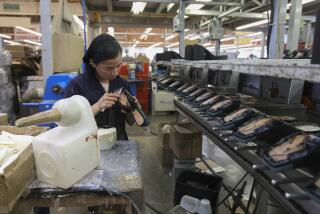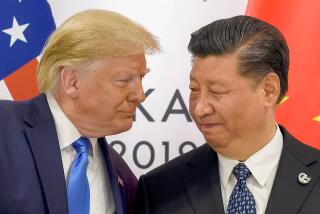Trade Deficit Worse in Last Quarter of ’88 : All-Year Imbalance Down 21.7% From ‘87’s All-Time High
WASHINGTON — The U.S. trade deficit worsened in the last three months of the year, climbing to $32 billion, the government reported today.
The Commerce Department said the deficit from October through December swelled 10% from a third-quarter deficit of $29.17 billion.
In spite of the larger trade imbalance in the final three months of the year, the deficit for all of 1988 dropped 21.7% to $126.5 billion, down from an all-time high of $160.28 billion set in 1987.
While economists were pleased with the big improvement for the year, they expressed fears that the trade improvement may have stalled out because of the worsening of the imbalance in the fourth quarter.
Smaller Figures
The trade figures today confirmed an improvement already noted in the Commerce Department’s monthly merchandise trade reports. Those figures showed the deficit declining to $137.34 billion in 1988, from $170.3 billion in 1987.
The new report, which measures trade on a balance-of-payments basis, shows smaller figures because it subtracts shipping costs and military sales from the monthly numbers.
The government also showed a worsening in the trade deficit for the fourth quarter in the report on the gross national product released today. Unlike the other trade figures, the GNP trade figures remove the effects of inflation.
Export, Import Records
Today’s report on merchandise trade on a balance-of-payments basis showed that both exports and imports reached record levels in the fourth quarter of 1988.
Exports increased $2 billion to $83.6 billion, while imports climbed by $4.8 billion to $115.7 billion.
The trade deficit with Japan also set a record, climbing by $3.2 billion to $15.5 billion in the fourth quarter.
For the year, the decline in the deficit to $126.5 billion reflected a 28% surge in export sales and a 9% rise in imports.
Farm Exports Shoot Up
Non-farm exports rose 28% to $61.6 billion, with the largest increases in sales of U.S. capital equipment and industrial supplies.
Agricultural exports shot up 30% to $38.3 billion, their highest level since 1984.
The largest increases were in sales of corn, which were up $1.9 billion, reflecting higher sales to the Soviet Union, Japan and Taiwan; and in wheat, which also climbed $1.9 billion, reflecting higher shipments to China and the Soviet Union.
The farm sales increase reflected in part higher prices caused by the severe drought. The average price of corn was up 38% for the year, while the price of soybeans rose 33%, wheat prices were up 20% and cotton prices rose 20%.
More to Read
Inside the business of entertainment
The Wide Shot brings you news, analysis and insights on everything from streaming wars to production — and what it all means for the future.
You may occasionally receive promotional content from the Los Angeles Times.










